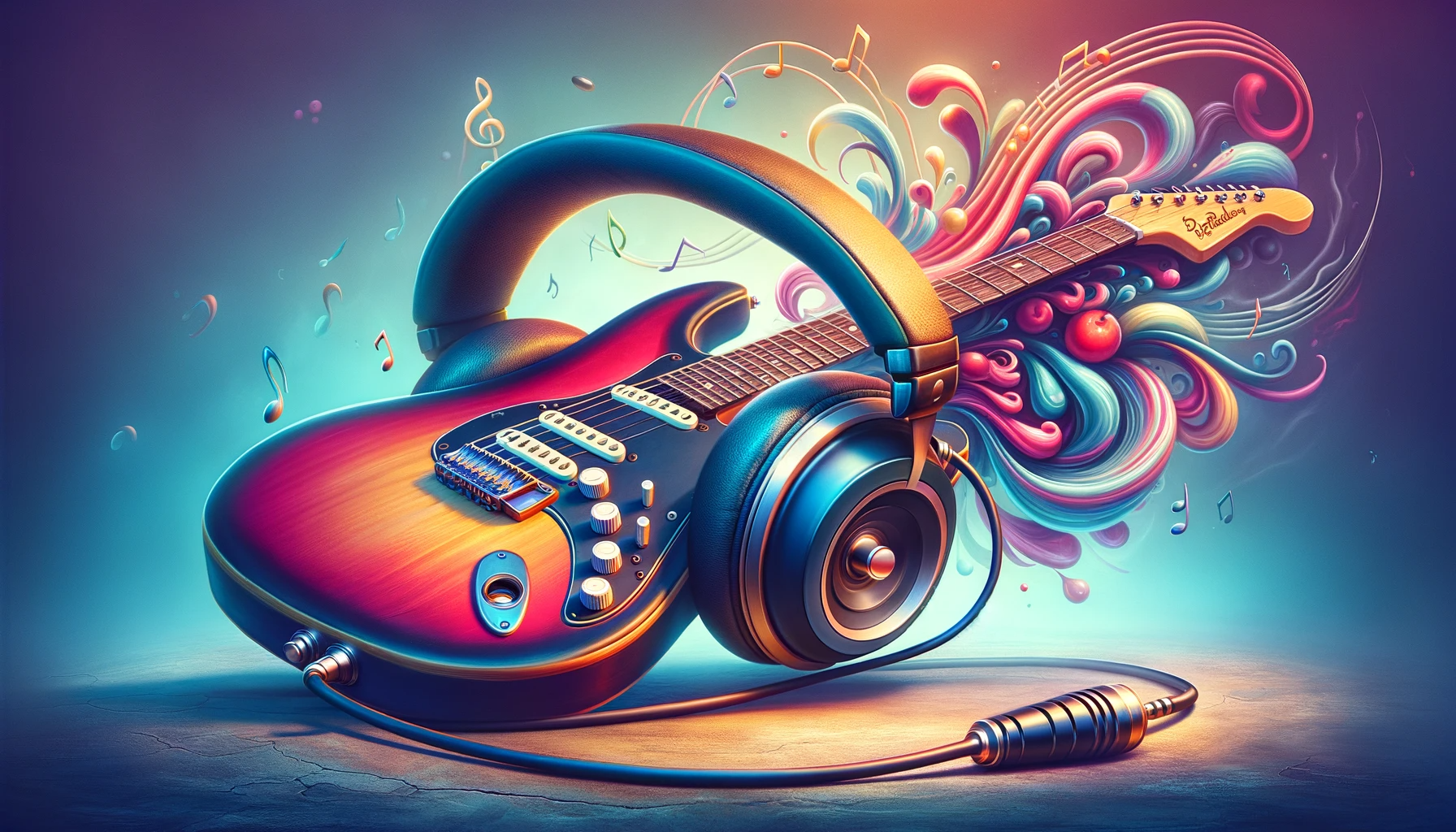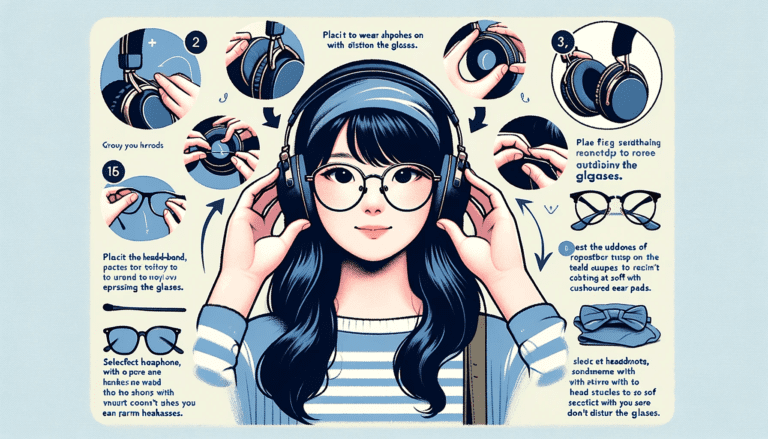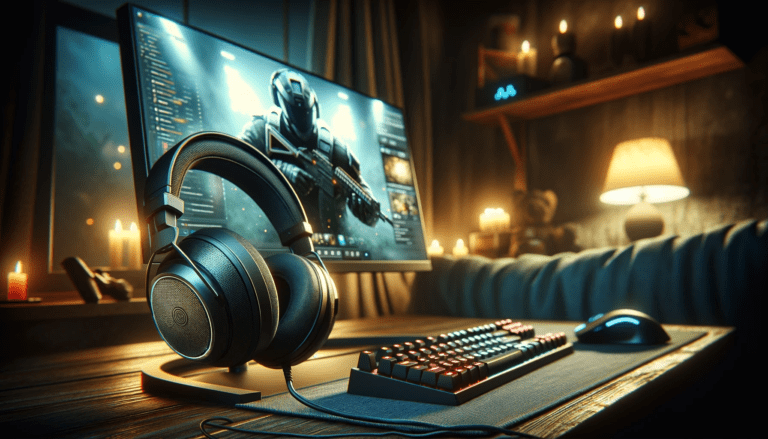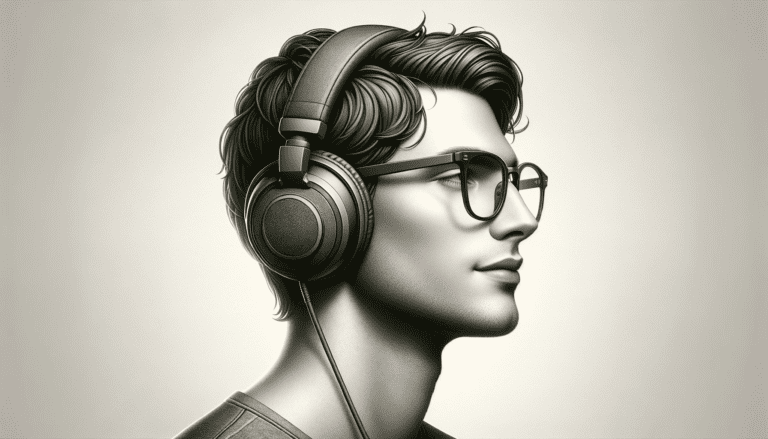Have you ever wondered, “Can You Plug Headphones into a Guitar?” It’s a question that might strike the mind of any aspiring guitarist or music enthusiast. Imagine the convenience of practicing without disturbing others, but is it possible?
The short answer is yes, but it’s not as straightforward as plugging headphones directly into a guitar. Most electric guitars require an intermediary device, like an amplifier with a headphone jack or a specialized guitar headphone amp. These devices help in converting the guitar’s signal into something your headphones can use.
But how does this setup influence your practice sessions and what are the best options available? Renowned guitar expert, Alex Turner, sheds light on the nuances of connecting headphones to a guitar. Let’s dive into the details and explore the world of silent guitar practice, ensuring you get the most out of your sessions without any compromise on sound quality.
Can you plug headphones into a guitar?
The short answer is yes. When it comes to plugging headphones into a guitar, we need to understand the traditional setup first. In a typical guitar setup, the signal from your guitar travels through various components before reaching the speaker for sound projection. The signal flow starts at the pickups, which capture the vibrations of the strings and convert them into electrical signals.
These signals then pass through volume and tone controls on your guitar, allowing you to adjust the sound characteristics. From there, the signal is sent to an amplifier via a cable.
The amplifier amplifies and shapes the sound according to your desired settings. This amplified signal is then sent out through either a speaker or an output jack, providing you with audible sound for everyone around.
Guitar signal flow through an amplifier
When you connect your headphones directly to a standard electric guitar’s output jack, you bypass one crucial component – the amplifier. Without an amplifier in between, there won’t be any amplification or tone shaping happening before reaching your ears.
As a result, you may hear only a faint and unimpressive audio signal that lacks depth and richness. To achieve optimal audio quality with headphones connected, it’s essential to use additional equipment in conjunction with your guitar – such as a headphone amplifier or dedicated headphone output.
Output options for sound projection
In a traditional setup without headphones involved, once your electric guitar’s audio is amplified by an amp head or combo amp, it is typically projected through one or more speakers connected to the amp cabinet. The most common option for connecting speakers is using speaker cables that are plugged into specific outputs on the back of the amp head or combo amp.
These outputs are usually labeled as “Speaker Out” or “External Speaker.” By connecting speakers this way, you ensure that there is sufficient power to move the speakers, producing the desired volume and tone. Plugging headphones directly into these outputs is not recommended, as it can result in improper functioning or even damage to your headphones.
Remember, when it comes to sound projection options for guitars, speakers are optimally designed to handle the power output of amplifiers and provide the full range of frequencies. Headphones are designed differently, focusing on personal listening rather than filling a room with sound.
So, if you want to enjoy your guitar’s sound privately through headphones without sacrificing audio quality or risking harm to your equipment, exploring alternative methods like headphone amplifiers or specialized headphone outputs is a recommended approach. Remember to stay tuned for our next section where we delve into using a headphone amplifier for plugging headphones into a guitar! You may read also How to Replace Headphone Pads
Alternative ways to connect headphones to a guitar
Using a headphone amplifier
So, let’s say you want to jam out on your guitar without disturbing the entire neighborhood. Enter the headphone amplifier, your trusty companion in achieving silent but soulful shredding sessions.
A headphone amp is a nifty little device that connects your guitar and headphones, allowing you to hear the sweet tones of your guitar directly in your ears. The purpose of a headphone amp is simple: it takes the signal from your guitar and boosts it up to a level suitable for driving headphones.
Think of it as a miniaturized version of the amplifier that typically powers those massive speaker cabinets on stage. The beauty of headphone amps lies in their ability to faithfully reproduce the nuances and dynamics of your playing while preserving tonal integrity.
Functionality and connection to the guitar signal chain
A headphone amp usually features multiple controls, such as volume and tone knobs, which allow you to tailor the sound according to your preferences. Some models even offer built-in effects like reverb or distortion, granting you an entire tonal playground at your fingertips.
To connect a headphone amp to your guitar signal chain, simply plug one end of an instrument cable into the output jack of your guitar (or effects pedals), and then connect the other end into the input jack on the headphone amp. From there, plug in any standard pair of headphones into the dedicated output jack on the amplifier.
This setup effectively bypasses traditional amplifiers altogether, channeling the raw sound from your guitar directly into your ears. It’s worth noting that some advanced models even feature additional outputs like line out or USB connectivity for recording purposes or connecting external audio interfaces.
Wireless options for cord-free rocking
[Subtitle: Breaking Free from the Chains] Now, let’s take it up a notch and explore the realm of wireless systems for guitars. These marvels of technology liberate you from the tyranny of cables, granting you unparalleled mobility and freedom on stage or at home.
Wireless guitar systems consist of two main components: a transmitter that plugs into your guitar’s output jack and a receiver that connects to your headphones or amplifier. The transmitter wirelessly sends your guitar’s signal to the receiver, allowing you to wander around the room or perform acrobatics on stage without fear of getting tangled up.
These systems utilize various technologies like radio frequency (RF) or digital transmission to ensure reliable and high-quality audio delivery. Some models even offer additional features such as multiple channels for interference-free performance or built-in rechargeable batteries for convenience.
While wireless guitar systems provide versatility and convenience, it’s important to consider factors like battery life, signal strength, and potential interference in crowded venues. Nonetheless, they remain an exciting option for those seeking utter freedom while rocking out with headphones. You may read the guide on Can Headphones Survive the Washing Machine and Dryer
Wireless Headphone Options for Guitars
Intriguing Freedom: Introduction to wireless systems for guitars
When it comes to rocking out on your guitar, who wants to be tethered by cables and cords? That’s where wireless systems for guitars come in, offering a tantalizing sense of freedom and mobility.
These systems allow you to roam the stage or jam in your bedroom without worrying about tripping over cables or getting tangled up like a confused octopus. With a wireless setup, you can unleash your inner guitar god while maintaining audio transmission from your instrument to your headphones.
Untangling the Waves: How wireless technology works in this context
Wireless technology for guitars operates using radio frequency signals that travel through the airwaves instead of relying on physical connections. It typically consists of two components: a transmitter and a receiver.
The transmitter is connected to your guitar’s output jack, while the receiver is responsible for capturing the transmitted signal and converting it back into an audible format that can be heard through headphones. The magic lies in how this system handles audio transmission.
The transmitter converts the analog guitar signal into digital data, which is then modulated onto a carrier frequency before being transmitted wirelessly. On the receiving end, the signal is demodulated and converted back into an analog electrical signal that headphones can reproduce as sound.
Unleashing Your Inner Guitar Ninja: Benefits of wireless systems compared to wired connections
One of the primary advantages of going wireless with your headphones and guitar setup is the unrivaled freedom of movement it affords you. Whether you’re shredding onstage or practicing in your bedroom sanctuary, being able to roam freely without being constrained by cables allows you to truly connect with your instrument and perform with unparalleled energy. Additionally, wireless systems eliminate cable-related issues such as accidental unplugging or interference caused by other nearby electronic devices.
Say goodbye to those dreaded moments when your foot gets caught in a cable mid-solo or your cat decides to use it as a chew toy. That said, wireless systems are not without their downsides.
They can be more expensive compared to traditional wired setups, and there may be a slight compromise in audio quality due to potential signal loss or interference. However, modern advancements in wireless technology have significantly minimized these drawbacks, making wireless headphone options for guitars increasingly practical and accessible.
Striking a Balance: Weighing the drawbacks of wireless connections
While wireless systems for guitars offer remarkable convenience, it’s important to consider their limitations. The range of wireless transmission varies across different models, so make sure you choose one that provides adequate coverage for your needs.
Additionally, some wireless systems may introduce latency—a small delay between playing a note and hearing it through your headphones. This latency is usually minimal but can be perceptible and affect your playing experience, especially if you’re performing intricate solos or playing with precise timing.
Furthermore, the reliance on batteries in wireless systems means you need to stay on top of charging or replacing them regularly to ensure uninterrupted performance. It’s also worth noting that compatibility can vary depending on the specific headphone model or brand you choose.
While there are some considerations and trade-offs involved with using wireless headphone options for guitars, the freedom they provide is hard to match. Whether you’re an aspiring rockstar or an at-home enthusiast looking to elevate your guitar-playing experience, untethering yourself from cables could be the key to unlocking new levels of musical expression and creativity. You may check also How to Connect Jabra Headphones
Built-in headphone jacks on certain guitars
Description of guitars with integrated headphone outputs
Some guitar manufacturers have recognized the growing demand for convenient headphone connectivity and have started incorporating built-in headphone jacks into their instruments. These guitars are designed to allow players to directly plug in their headphones without the need for additional adapters or accessories. The placement and design of these jacks may vary, but they are generally located on the body of the guitar, near the output jack or control knobs.
Examples of specific models or brands
One notable example of a guitar with a built-in headphone jack is the Fender American Elite Stratocaster. This versatile electric guitar features an onboard preamp system that includes a dedicated headphone output.
Another popular option is the Yamaha Pacifica 112V, which also boasts a built-in headphone jack for private practice sessions. Some higher-end models like the PRS Custom 24 and Gibson Les Paul Standard have also incorporated this feature to cater to players who value convenience and flexibility.
Advantages and limitations of built-in jacks
The primary advantage of guitars with integrated headphone outputs is their ease of use. Players can simply plug in their headphones and start jamming without requiring any additional equipment. This eliminates the need for external amplifiers or separate devices like headphone amplifiers, streamlining the setup process.
However, it’s important to note that not all guitars come equipped with this feature, so availability may be limited depending on your preferred brand or model. Additionally, some players argue that built-in jacks can slightly compromise tone quality compared to using dedicated amplifiers or audio interfaces.
While these differences may be subtle to many ears, purists might prefer using traditional setups for optimal sound reproduction. If you’re frequently practicing in environments where volume control is necessary or if you prioritize convenience above all else, guitars with built-in headphone jacks can be a fantastic option.
They provide a straightforward way to connect your headphones directly to the instrument, eliminating the need for additional equipment. However, it’s worth considering personal preferences and tonal requirements, as some players may still prefer utilizing external amplifiers or headphone amplifiers to achieve the desired sound quality. You may read the ultimate guide on Why Do My Sony Headphones Keep Disconnecting
Headphone Adapters for Guitars without Dedicated Outputs
Overview of Various Adapter Options Available in the Market
When it comes to connecting headphones to a guitar that lacks a dedicated output, fear not, for there are adapter solutions readily available. These nifty gadgets act as intermediaries between your guitar and headphones, enabling seamless compatibility.
In the realm of adapters, you’ll encounter an array of options catering to different needs and preferences. One popular type of adapter is the quarter-inch to eighth-inch adapter.
This type allows you to connect your standard quarter-inch guitar cable into one end, while the other end features an eighth-inch jack that your headphones can be plugged into. It’s essential to ensure the adapter is of good quality since cheap ones may compromise sound clarity and introduce unwanted noise.
Considerations When Choosing an Adapter
When selecting an appropriate headphone adapter for your guitar setup, several factors must be considered. Firstly, pay attention to the build quality and durability of the adapter itself.
Opting for a well-constructed adapter will guarantee longevity and minimize potential signal loss or interference. Another aspect to consider is impedance matching.
Impedance refers to the electrical resistance within audio devices when they interact with each other. Ensuring that your headphone impedance matches or closely aligns with that of your guitar’s output will yield optimal sound quality.
Consequently, it’s advisable to consult product specifications or seek expert advice when uncertain about impedance compatibility. Furthermore, take note of any additional features offered by certain adapters.
Some adapters may include volume control knobs or other functionalities that enhance user experience and convenience during practice sessions or performances. Price should also be taken into account when choosing an adapter; however, it is worth remembering that investing in a reliable and high-quality adaptor will yield more satisfactory results in terms of audio quality and longevity.
Various headphone adapters are available in the market to enable the connection between guitars lacking dedicated outputs and headphones. Quarter-inch to eighth-inch adapters are commonly used for this purpose, providing a seamless transition from guitar cable to headphone jack.
When selecting an adapter, considerations such as build quality, impedance matching, additional features, and price should be taken into account. By choosing a suitable adapter that meets your specific needs and preferences, you can enjoy a hassle-free experience when plugging headphones into your beloved guitar.
Potential Issues when Plugging Headphones into a Guitar
Discussion on Impedance Matching between Headphones and Guitar Outputs
When it comes to plugging headphones into a guitar, one important factor to consider is the impedance matching between the headphones and the guitar’s output. Impedance is essentially the resistance to the flow of electrical current, and it plays a crucial role in maintaining audio quality.
Headphones typically have an impedance rating measured in ohms, while guitar outputs have their impedance level. If you connect headphones with an impedance rating that is significantly different from the guitar output’s impedance, it can lead to a mismatch.
This mismatch can result in poor audio quality and even damage to your gear. When there is an impedance mismatch, you might experience issues like distorted sound, loss of clarity, or excessively quiet or loud volumes.
Impact on Audio Quality and Potential Damage Risks
When plugging headphones into a guitar without considering impedance matching, you risk compromising the audio quality. For instance, if your headphones have a higher impedance than what the guitar output expects, you may experience dampened volume levels or an overall loss of tonal quality. On the other hand, if your headphone’s impedance is lower than what the guitar output requires, sound distortion and potential damage to both your headphones and amp may occur due to excessive current flow.
It’s crucial to note that some modern headphone amplifiers or built-in headphone jacks on certain guitars are designed with appropriate circuitry for impedance matching. However, when connecting regular headphones directly to a standard 1/4-inch output jack without such features, precautions should be taken.
Tips for Avoiding Problems
To avoid these potential issues when plugging headphones into a guitar: 1. Check headphone specifications: Before connecting your headphones to a guitar output directly or via an adapter, ensure that the impedance range of your headphones is compatible with the guitar output.
This information can usually be found in the product manual or on the manufacturer’s website. 2. Use a headphone amplifier: If you frequently desire to play your guitar through headphones, consider investing in a dedicated headphone amplifier.
These amplifiers are designed specifically for driving headphones and often offer adjustable impedance settings to match your headphones’ requirements. 3. Use impedance matching adapters: If you need to connect headphones with a different impedance rating from your guitar output, consider using an impedance matching adapter.
These adapters help bridge the gap and ensure proper signal transfer without compromising audio quality or risking damage. Taking the time to understand and address potential impedance mismatch issues will help you enjoy high-quality sound while protecting both your guitar and headphones from any harm or unnecessary wear and tear. You may check also How to Connect Beats Headphones to MacBook
Conclusion
Recap: Throughout this article, we have explored the topic of plugging headphones into a guitar and delved into various aspects of this compatibility. We began by understanding the traditional setup of a guitar and its connection to an amplifier for sound projection.
We then explored alternative methods, such as using a headphone amplifier or wireless systems, to connect headphones directly to guitars. Additionally, we discussed guitars with built-in headphone jacks and different adapter options for guitars without dedicated outputs.
We touched on potential issues related to impedance matching and provided tips for avoiding problems.
Final Thoughts: Plugging headphones into a guitar opens up a whole new world of possibilities for guitarists.
It allows for private practice sessions without disturbing others or even jamming along with your favorite tracks late at night. While there may be some technical considerations involved in finding the right equipment and ensuring proper impedance matching, the convenience, and versatility that headphone connectivity brings are well worth it.
So go ahead, and explore your creativity with headphones plugged into your guitar! Whether you’re a professional musician or an enthusiastic beginner, this option offers a fantastic way to hone your skills and enjoy playing without limitations.
While it’s crucial to understand the compatibility between headphones and guitars before attempting any connections, plugging headphones into a guitar can greatly enhance your playing experience. So grab your favorite pair of headphones, find the right adaptors or amplifiers if needed, and embrace the freedom that comes with being able to plug in your trusty instrument anytime you want – without disturbing those around you.







